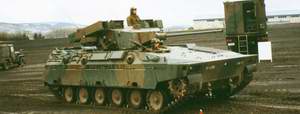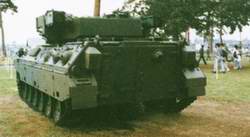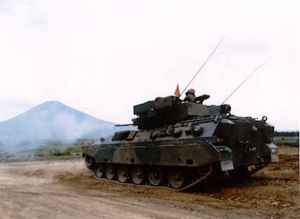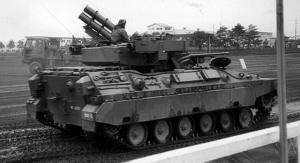| Designation: | Type 89 |
 |
|---|---|---|
| Manufacturer: | Mitsubishi Heavy Industries | |
| Product type: | Armoured Vehicles | |
| Name: | Infantry fighting vehicle |
The 1984 Japanese defence budget included a JPY600 million request for the construction of four prototypes of a new mechanised infantry combat vehicle. In FY81 funding was provided for prototypes of the turret and hull. Following trials with the prototype vehicles, it was type-classified as the Type 89 Mechanised Infantry Combat Vehicle and it is now in production for the Japanese Ground Self-Defence Force, with the initial requirement being for 300 vehicles.
Production of the Type 89 has been undertaken at a very low rate and, by the end of 1999, only 58 vehicles were in service with the Japanese Ground Self-Defence Force. Since then it is understood that production has continued at a low rate and over 70 vehicles have now been built. Recent information is that production of the Type 89 is now complete.
Prime contractor for the Type 89 MICV is Mitsubishi Heavy Industries, although a major subcontractor is Komatsu. In FY1999 two vehicles were procured, and in FY2000 just one vehicle. It is considered possible that a follow-on vehicle to the Type 89 MICV is being developed in Japan. It is known that an 8 × 8 wheeled MICV is also under development.
The hull of the Type 89 MICV is of all-welded armour construction which provides the crew with protection from small arms fire and shell splinters. Mounted under the nose of one of the prototype Type 89 MICVs were attachment points for a mine clearance system.
The power pack is mounted at the front of the vehicle on the left side with the exhaust outlet on the left side of the hull, the driver being seated on the right and one of the seven infantrymen to his immediate rear.
The driver has a single-piece hatch cover that opens to the right. In front of this are three day periscopes. In the driver's roof hatch is a day periscope, which can be traversed. One of the driver's day periscopes can be replaced by a passive night vision device. The infantryman to the rear of the driver has a single-piece hatch cover, periscopes that give observation to the front and sides and a spherical firing port in the right side of the hull.
The two-man power-operated turret is in the centre of the hull, with the commander seated on the right and gunner on the left, both having single-piece hatch covers opening to the rear. Both the commander and gunner have a roof-mounted periscopic sight mounted in the forward part of the turret. The gunner has two fixed day periscopes to give observation to his front and left side, and the commander has six day periscopes giving observation to the front, sides and rear. Mounted on the turret roof is a laser warning device, which is also fitted to most recent production Japanese AFVs.
Main armament is an Oerlikon Contraves 35 mm KDE cannon which has a cyclic rate of fire of 200 rds/min. First weapons were supplied direct from Switzerland, with licensed production then being undertaken in Japan. A 7.62 mm Type 74 machine gun is mounted coaxially to the left of the locally manufactured Oerlikon Contraves 35 mm KDE dual-feed cannon and either side of the forward part of the turret is a bank of three electrically operated smoke grenade dischargers firing forwards.
Mounted either side of the turret is a single Jyu-MAT medium-range wire-guided anti-tank missile developed by Kawasaki Heavy Industries. These have a maximum range of at least 4,000 m. Replacement missiles are loaded via the rear troop compartment hatches.
The raised troop compartment is at the rear of the hull, with the troops entering and leaving via two doors in the rear that open outwards. The right door has a spherical firing port. There are a further three firing ports in the right side of the troop compartment and three in the left side, each of which has a roof-mounted day periscopic sight. Over the top of the troop compartment is a two-part roof hatch that opens left and right of the vehicle's centreline. There are a further two roof-mounted day periscopes which give observation to the rear of the vehicle.
Of the six infantrymen seated in the rear, the three on the left side face outwards, the first two on the right side face outwards and the third sits facing the rear.
Suspension is of the torsion bar type with either side having seven dual rubber-tyred road wheels, drive sprocket at the front, idler at the rear and three track-return rollers.
The vehicle does not have any amphibious capability, but is fitted with an NBC system and a full range of passive night vision equipment.
There are no known variants of the Type 89 mechanised infantry combat vehicle although a modified version of its chassis may be used for a new 155 mm self-propelled artillery system. Available details are given in a separate entry.
|
||||||||||||||||||||||||||||||||||||
|
|||||||||
|
||||||||||||
 |
 |
 |
 |
 |
 |

